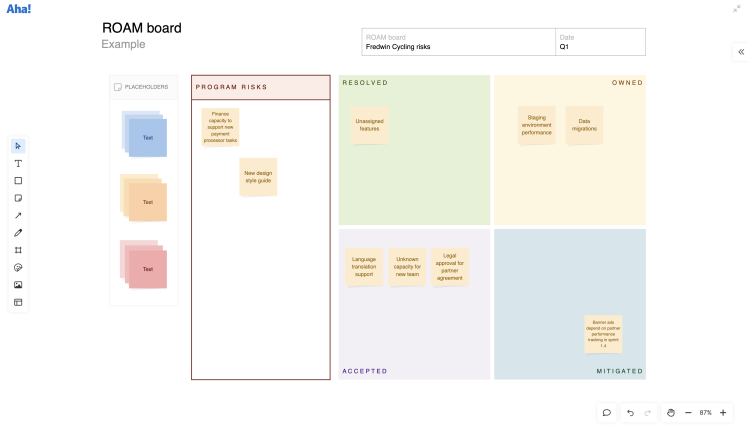ROAM board template
Categorize the risks in your SAFe program by resolved, owned, accepted, and mitigated work items
Use template
About the ROAM board template
ROAM is an agile risk management approach to help teams identify potential risks and determine the best way to handle them. Use this ROAM template to organize risks into four categories — resolved, owned, accepted, and mitigated — so the team can take appropriate actions to address them.
Many SAFe® organizations use a ROAM board during program increment (PI) planning. Teams capture risks and impediments that could impact their ability to deliver the PI. The agile release train (ART) collectively discusses the impact of each risk before voting on their overall confidence level to meet the PI objectives.
Keep the ROAM board up to date as your program increment gets underway. This gives the team full visibility into the status of risks and the level of concern associated with each one. The ROAM board is one component of the SAFe PI planning template series, which includes a PI board, team sprint planning, and retrospective templates. Leverage these templates separately or all together to guide your complete planning session.
Best practices
Conduct a thorough risk assessment during PI planning to identify any impediments impacting the team's ability to deliver on time. Use this template to forecast and report on program risks with your team.
Identify the risks Work with your team during program planning to identify and explore all the risks that may keep you from achieving your objectives. Add each as a sticky note in the left column and discuss.
Assign to categories Place each risk into one of the four quadrants based on how you plan to approach it. Resolved risks no longer present a threat. Owned risks have been assigned to a teammate who will manage them. Accepted risks have been approved by the team and will not be addressed. Mitigated risks have an agreed-upon plan for alleviation.
Manage PI risks Review the ROAM board regularly to track progress of owned risks — moving sticky notes to a different quadrant or amending them with additional notes. Add any new risks that emerge as work gets underway.